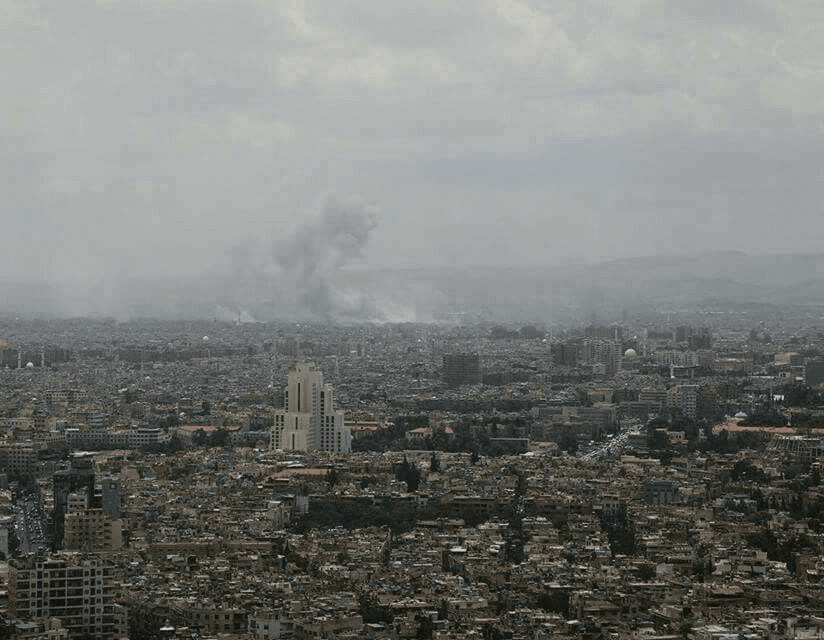Pro-government forces close in on holdout Islamic State districts in south Damascus
AMMAN: Syrian government forces and allied militias are fighting a […]
15 May 2018
AMMAN: Syrian government forces and allied militias are fighting a “building-by-building” battle against dug-in Islamic State (IS) fighters in south Damascus, where hundreds of civilian residents remain trapped behind the frontlines.
The Syrian Arab Army (SAA) and its allies, now in the fourth week of an anti-IS offensive in south Damascus, are making slow but steady advances against the hardline group’s positions, a media spokesman for Liwa al-Quds, a pro-government Palestinian militia participating in battles, told Syria Direct via Facebook on Monday.
“The nature of the terrain and the crowded urban layout of buildings mean that the battle takes on a unique style,” said the spokesman.
The soldiers of Liwa al-Quds, fighting under the banner of the SAA, are working to dislodge entrenched Islamic State fighters who have controlled territory in south Damascus since mid-2013.
“Buildings are mined and booby-trapped so advances are slow,” the Liwa al-Quds representative said, adding that IS fighters are “depending on tunnels which they have been preparing for years.”
Pro-government forces, in their most recent advance, reportedly captured several buildings from IS on Saturday including two schools, according to the pro-government Central War Media. Syrian state media has not reported any major advances by the SAA or its allies since the weekend.

The UK-based Syrian Observatory for Human Right estimates that roughly 140 fighters have been killed on both sides since the government offensive began on April 19, according to a report published by the monitor on Tuesday.
As of Tuesday, the Islamic State maintains control of a less than two-square-kilometer pocket of territory in south Damascus spanning a large section of Yarmouk, a Palestinian refugee camp that is part of metropolitan Damascus, as well as parts of the adjacent a-Tadamon and al-Hajar al-Aswad districts.
The besieged IS-held pocket is the last section of territory outside of government control in Damascus and its countryside.
Since launching their anti-IS offensive on April 19, pro-government forces have advanced along several axes and wrested control of dense urban areas from IS in the al-Hajar al-Aswad and a-Tadamon districts. Daily airstrikes and artillery shells have accompanied the fighting.
With the first week of fighting, thousands of civilian residents of the encircled, IS-held southern neighborhoods of Damascus fled bombardment and clashes for then-opposition-held districts nearby, Syria Direct reported at the time.
Those districts later surrendered to the government and as residents and fighters evacuated to opposition-held northern Syria in recent weeks.
Today, pro-government forces are “narrowing in on Daesh [IS], whose remnants are concentrated in the Palestinian camp,” said the Liwa al-Quds media spokesman, referring to Yarmouk. “The final battle will be there.”
The Action Group for Palestinians of Syria (AGPS), a London-based monitoring group with correspondents on in south Damascus, estimates that the government-led offensive on IS positions in south Damascus has destroyed “60 percent of the Yarmouk camp,” according to a report published by the London-based monitor on Monday.
A Syrian Arab Army tank in the al-Hajar al-Aswad district in south Damascus on May 8. Photo courtesy of SANA.
“There are still civilians in Yarmouk who are stranded . . . and are in dire need of safe passage to leave the area,” read a statement by Pierre Krähenbühl, Commissioner-General of the United Nations Relief and Works Agency (UNRWA), provided to Syria Direct on Tuesday by the UN agency’s field office in Damascus.
“All parties to the fighting should exercise maximum restraint to ensure that civilians are spared,” said Krähenbühl. “[They] should take measures to prevent unnecessary damage to civilian infrastructure.”
Fayez Abu Eid, a member of the media team for the Palestinian monitoring group AGPS, told Syria Direct late last week that “the number of civilians remaining [in Yarmouk] does not exceed 1000.”
Fernande van Tets, a communication officer for the UNRWA field office in Damascus, told Syria Direct via email on Tuesday that an estimated 100-200 civilians remain in the Yarmouk.
“Most of the civilians now in those neighborhoods are elderly or refuse to leave their homes,” said Jalal al-Yarmouki, a 25-year-old Palestinian who left his home in the refugee camp after the government offensive began in April. The former Yarmouk resident asked to be referred to by a pseudonym as he was departing south Damascus last week for northern Syria as part of a government-coordinated evacuation.
Both al-Yarmouki and another recently displaced resident told Syria Direct last week that when they fled Yarmouk most families in the Palestinian refugee camp were taking shelter in overcrowded basements.
“We could hear the terrifying sounds of bombardment [from underground],” Rabiah Abu Ahmad, who fled IS-Yarmouk to the nearby town of Yalda roughly two weeks ago, told Syria Direct last week. “We only saw the damage when the bombings would pause and we could go out to catch our breaths.”
The residents that remained in the Yarmouk camp, crammed together in basement shelters, only have access to small quantities of nonperishable foods—lentils, rice and other grains, says al-Yarmouki.
UNRWA Commissioner General Krähenbühl, in the statement provided to Syria Direct, warned of a “rapidly deteriorating” humanitarian situation in the Yarmouk camp as fighting drags on, with remaining residents low on supplies of food and medicine and no running water.








